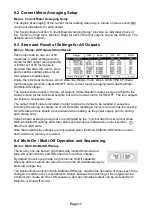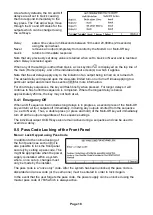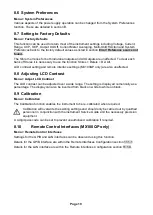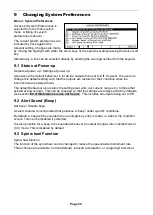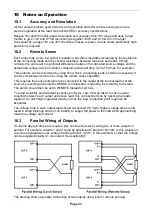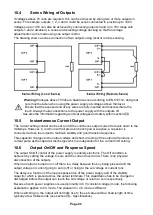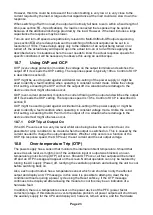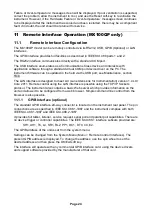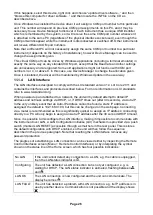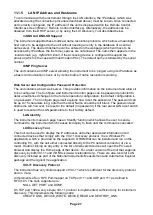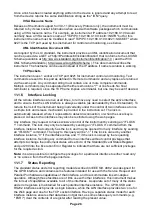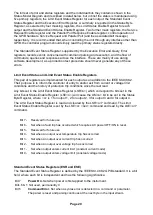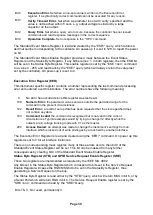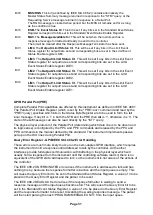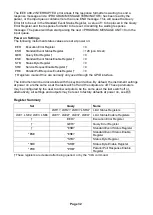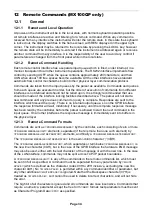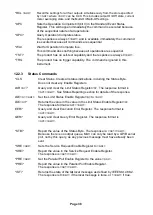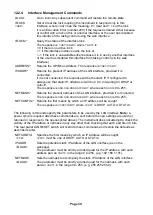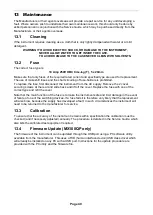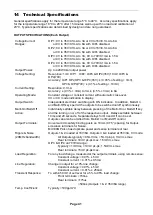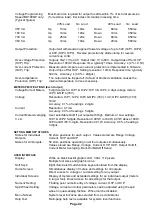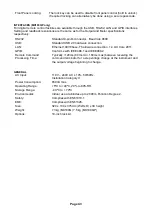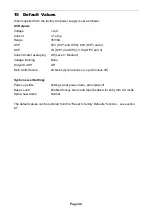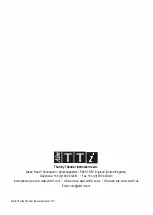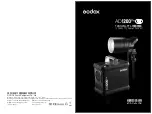
Page 31
Bit 6
MSS/RQS
. This bit (as defined by IEEE Std. 488.2) contains alternatively the
Master Status Summary message returned in response to the *STB? query, or the
Requesting Service message returned in response to a Serial Poll.
The RQS message is cleared when polled, but the MSS bit remains set for as long
as the condition is true.
Bit 5
ESB.
The
Event Status
Bit. This bit is set if any bits set in the Standard Event Status
Register correspond to bits set in the Standard Event Status Enable Register.
Bit 4
MAV.
The
Message Available
Bit. This will be set when the instrument has a
response message formatted and ready to send to the controller.
The bit will be cleared after the Response Message Terminator has been sent.
Bit 3
LIM4
. The
Output4 Limit Status
Bit. This will be set if any bits in the Limit Event
Status register for output4 are set and corresponding bits are set in the Limit Event
Status Enable register LSE4.
Bit 2
LIM3
. The
Output3 Limit Status
Bit. This will be set if any bits in the Limit Event
Status register for output3 are set and corresponding bits are set in the Limit
Event Status Enable register LSE3.
Bit 1
LIM2
. The
Output2 Limit Status
Bit. This will be set if any bits in the Limit Event
Status register for output2 are set and corresponding bits are set in the Limit
Event Status Enable register LSE2.
Bit 0
LIM1
. The
Output1 Limit Status
Bit. This will be set if any bits in the Limit Event
Status register for output1 are set and corresponding bits are set in the Limit
Event Status Enable register LSE1.
GPIB Parallel Poll (PRE)
Complete Parallel Poll capabilities are offered by this instrument as defined in IEEE Std. 488.1.
The Parallel Poll Enable Register (which is set by the *PRE <
NRF
> command and read by the
*PRE? query) specifies which bits in the Status Byte Register are to be used to form the
ist
local message. If any bit is ‘1’ in both the STB and the PRE then
ist
is ‘1’, otherwise it is ‘0’. The
state of the
ist
message can also be read directly by the *IST? query.
The physical layer protocol of the Parallel Poll (determining which data line is to be driven and
its logic sense) is configured by the PPC and PPE commands and released by the PPU and
PPD commands in the manner defined by the standard. The instrument implements passive
pull-up on the DIO lines during Parallel Poll.
Query Error Register - GPIB IEEE Std. 488.2 Error Handling
These errors are much more likely to occur on the semi-duplex GPIB interface, which requires
the instrument to hold a response until addressed to talk by the controller. All the other
interfaces provide full duplex communication, with buffering in the physical layer which will
usually hold a response from the instrument until the controlling software reads it; there is no
equivalent of the GPIB state ‘addressed to talk’, so the instrument is not aware of the actions of
the controller
The IEEE 488.2 UNTERMINATED error arises if the instrument is addressed to talk and has
nothing to say, because the response formatter is inactive and the input queue is empty. This
will cause the Query Error bit to be set in the Standard Event Status Register, a value of 3 to be
placed in the Query Error Register and the parser to be reset.
The IEEE 488.2 DEADLOCK error arises if the response formatter is waiting to send a
response message and the input queue becomes full. This will cause the Query Error bit to be
set in the Standard Event Status Register, a value of 2 to be placed in the Query Error Register
and the response formatter to be reset, discarding the waiting response message. The parser
will then start parsing the next <PROGRAM MESSAGE UNIT> from the input queue.

